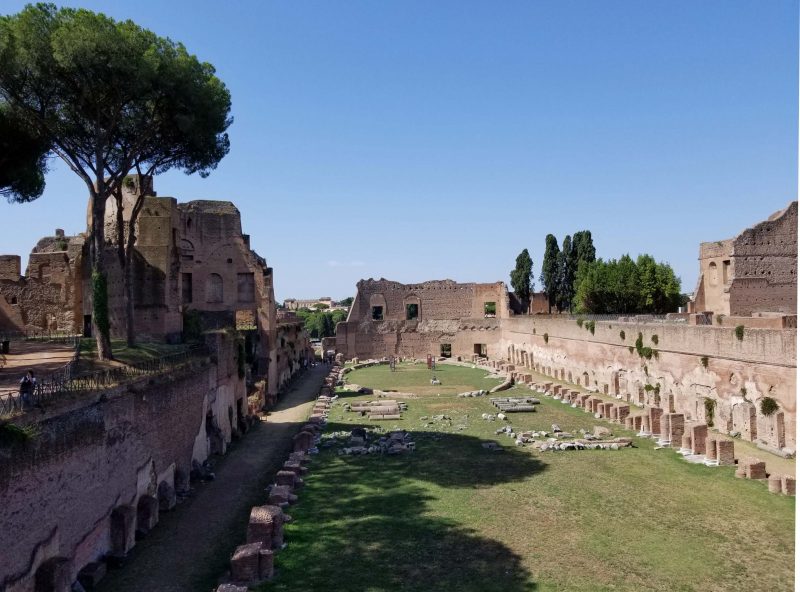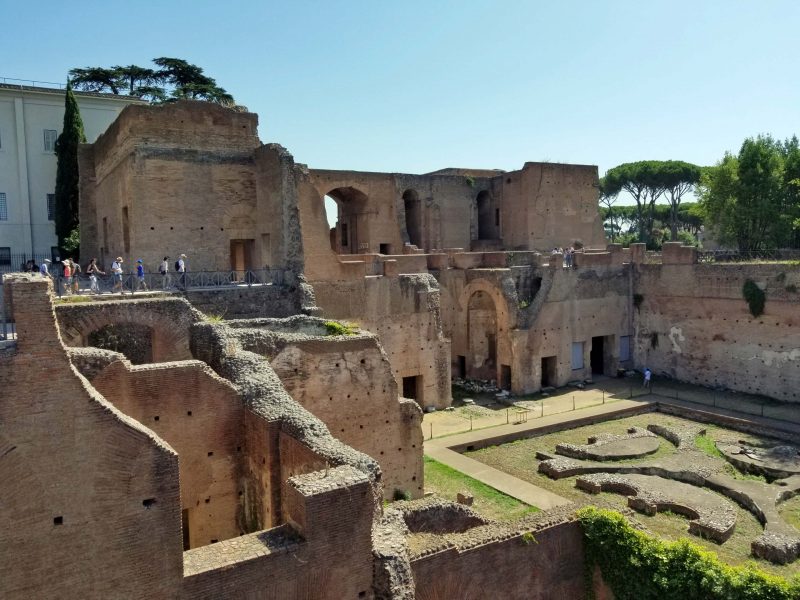Ted and I had a private tour of the Coliseum. It was just the two of us and an outstanding guide who really knew her Roman history. The tour included Palatine Hill, the Roman Forum, and the Coliseum. Our guide said we needed to begin our tour with Palatine Hill, which is beside the Coliseum, because Rome’s history starts on Palatine Hill.
The seven hills of what is now Rome stood above the Tiber River. People built on the hills because the lower land was a swamp. Nero decided to build the largest palace in the world on Palatine Hill. Would you believe the Palace included central heat and air conditioning back in 68 A.D.? Fire warmed the Palace floors in winter and an elaborate water system sent water throughout the Palace to fountains and pools to cool it in the summer. The system sent waste water into the Tiber River.

The following photos show only parts of the Palace, but the ruins indicate how large it was.



Some of the Palace floors were double. Heat from fires was directed into the space between the double floor to heat the stone. Radiant heat from the stone floors then warmed the palace rooms. Sometimes, the stone floors became so hot that they warped (second photo).


Note: The top-heavy trees in the photo above are called umbrella pines. They can be seen everywhere in the city. The trees grow so wide and heavy that they fall over unless they are pruned, giving them an umbrella shape.

The Palace, the Roman Forum, and the Coliseum are all on Palatine Hill. I took the following pictures from the hilltop near the Palace.

The House of the Vestal Virgins was home to the priestesses of the goddess Vesta. Six priestesses between the ages of 6-10 were chosen to serve for 30 years. During that time, they had to remain chaste. Punishments for infractions of their rules were severe, including lashing, pouring molten lead down their throats, and burying them alive. (Certainly an incentive to obey the rules!) After their service, they were allowed to marry, but usually didn’t because it was considered bad luck to do so after being consecrated to Vesta. When the Roman Empire fell, many blamed it on the conversion to Christianity and forsaking the old gods.


The Coliseum was built for entertaining palace guests. There is as much of the Coliseum below ground as above. The foundations are 40 feet deep and 10 feet wide to support the weight of the building. There was a point at which the government could no longer afford the upkeep for the Coliseum, so it was shut down around 500 A.D. and used for simple housing–no more than a room with walls, a ceiling, and a door. During this time, Rome’s population decreased from 1,000,000 to 25,000.
There were two stages for performing in the Coliseum, so two performances could occur simultaneously. Four tunnels provided access to the Coliseum from different points. One tunnel connected the palace to the Coliseum for the Emperor’s convenience. The Coliseum had 24 elevators, operated by over 200 slaves turning wheels to operate pulleys. The entrances were numbered, just like today’s stadiums, and some of the gate numbers were still visible. Our guide pointed out entrance IIII. At that time, IIII was the Roman numeral for 4. It is now written as IV.
Part of the Coliseum has been restored, and work is progressing on other parts. Some of the restored central arena is now used for concerts. (Steven Tyler performed in the Coliseum in 2017.)



Mussolini tore down much of the Forum, the Palace, and the Coliseum because he wanted to build a road for his military parades. He then built a palace for himself on Palatine Hill. People disparagingly called it “the square Coliseum.”

There is a saying that “all roads lead to Rome,” but our guide said it should be the other way around: “All roads begin in Rome.” Rome was considered to be the center of civilization, and there is a marker on Palatine Hill to indicate the center of Rome (cf the first paragraph, above). Markers were placed on Roman roads throughout the entire Roman Empire to indicate the distance from the marker to the center of Rome. Many of those roads still exist, including the Appian Way, ancient Rome’s most important military and economic artery.
Mythbusters: (1) Ben Hur’s chariot race did not take place in the Coliseum. The races were held in the Circus Maximus in the valley between Palatine Hill and Aventine Hill, an area that could seat 250,000 people. (2) Gladiators did not fight to the death. It was expensive to train and outfit gladiators, so they were not supposed to kill each other. Their contests were more like today’s wrestling.
Tonight: Another classic Italian meal–spaghetti. We topped it off with the best cheesecake we’ve ever had. It made Cheesecake Factory look like a beginner.
